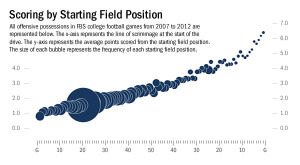Why Are Punters Important?
If kickers are “not real football players” then what does that make punters? I mean kickers put points on the board and can win the game in the last second. Well so can punters. Maybe not points, but punters can definitely win the game in the last second and change the outcome of the game. A few games come to mind in my career, but I will share one from my high school days.
 You never really think of winning a game with a punt, but that is exactly what happened.
You never really think of winning a game with a punt, but that is exactly what happened.
The scenario…my high school was up by 2 points after a planned safety with 28 seconds to play. I had to run onto the field and get a good punt off so the other team couldn’t throw a long ball into the end-zone and potentially win the game.
The resulting punt (about a 45 yard punt) and coverage (-9 yard return) pinned the other team back far enough that their hail mary’s were of no real threat.
Pinning the competition back has its advantages.
How Does This Apply To Punters?
Punters play a crucial role in the battle of field position. In a defensive game, think of it as a battle of tug of war. You are trying to out punt the other team and push them back to the left side of the chart above. You want them to have to go the length of the field to score, and according to statistics, they will only score 0.5 points on average. But on the other hand, shank a punt and your opponent is likely to score 2.5+ points on average. So while you are not directly putting points on the board, you are the first line of defense in preventing the other team from scoring!
The Stats Of Field Position
For every yard farther back you pin your competition, the less likely they are to score points. It is actually quite remarkable to see the stats. These stats are based on D-1 FBS games from 2007 to 2012. As you will see, teams are much less likely to score the further they have to go. As the old saying goes, “numbers don’t lie.”

Reading the chart: On the left side is the opponent starting from their own 1 yard line. On the far right side is if the opponent only had 1 yard to go. The size of the dot is how often the teams start at that yard line. The 20 yard line is most common due to touch backs. As the dots rise, you will see the points go from under 1 point to over 6 points.
